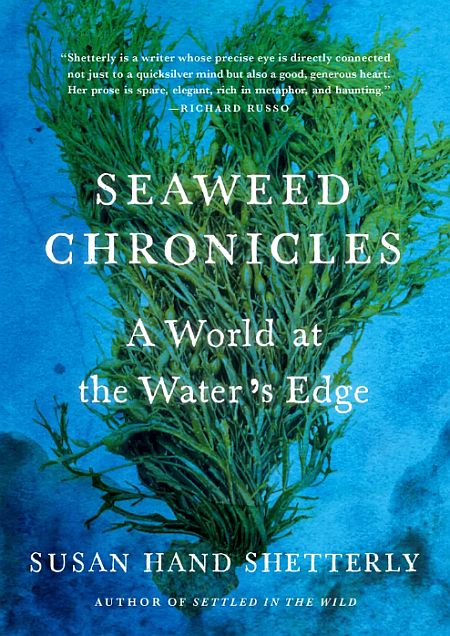
Seaweed Chronicles

I reviewed Susan Hand Shetterley’s Settled in the Wild in Summertime a while ago. She writes so very particularly about nature and so very poetically that the pages turn and memories surface of what I have observed in our beautiful state of Maine. Her Seaweed Chronicles describes our Gulf of Maine, “A World at the Water’s Edge.”
“Out of water, the seaweed looks like a pale purple scrunch of Saran warp lying in the sun.” I saw this at Higgins Beach near Portland more than once at low tide. I bet many of you beach goers have seen this shiny site, almost reaching to pick up a piece of Saran Wrap.
When Susan Hand Shetterly mentions a woman scientist from Wales who was honored on the beaches of Japan for her life long studies of seaweed, I notice. How fascinating to have seaweed world lessons that can be applied to our rich coastal waters. The author also goes into the ages of ice and eons of centuries when those mammoth boulders were shoved. “[T]he Gulf of Maine was born, with deep troughs from the ancient fire and the high, cobbled hills made by ice.”
Kathleen Drew-Baker from the U.K. collected seaweed and now sushi is wrapped in it, famous food from Japan. Do you ever enjoy rice balls or soups seasoned by seaweed? Taxes were paid in Japan to the emperor long ago with nori, valuable seaweed used as cash by the peasants.
The British Phycological Society recognized Kathleen’s seaweed discoveries before she died in 1957. “Here on the Maine coast, the coves (like Higgins Beach) where laver predominates are mostly found along cobbled Downeast shores, where the tides pull away and the mussel beds…are exposed together.” Memories from this author’s Settled in the Wild pop up as she dug for fresh mussels for meals almost daily.
Living on our land without spoiling it is a theme in both of Shetterly’s nature books. She quotes Aldo Leopoldo: “Our tools are better than we are, and grow faster than we do. They suffice to crack the atom, to command the tides, but they do not suffice for the oldest task in human history, to live on a piece of land without spoiling it.”
Whales were almost destroyed by modern forms of whaling. Dr. Stephen Katona of Bar Harbor’s College of the Atlantic was interviewed about modern whaling carnage as compared to Moby Dick times. So too, harvesting of seaweed: “The third method, used primarily in Midcoast Maine, is the mechanical harvester: a flat-bottomed boat with a rotary cutting head and a suction hose that pulls over the cut weed and spews it into netted bags.”
Nova Scotia had destructive seaweed cutting years ago that has been outlawed. Our Maine Seaweed Council preserves and protects the rich seaweed along our Gulf of Maine fertile shores. I can almost smell that salty air and taste the seaweed flavor enhancers.
“To work in beauty is a gift…it’s a human birthright of sorts, working where the sun rises, the day clears, the smells of the wild world are all around you, and you are a part of something very old, very big.” The author’s friend Sarah has a laugh because she’s spent days in cold winter snows working in “serious cold.”
Lobstermen have become interested in kelp farming as the seasons change for different foods. Sarah Redmond of the independent inshore aquaculture thinks Maine could become the “new Japan.” Maybe we have by now, for this study was published in 2018.
Richard Russo writes, “Shetterly is a writer whose precise eye is directly connected not just to a quicksilver mind but also a good, generous heart. Her prose is spare, elegant, rich in metaphors, and haunting.” Read and find out for yourself.
Prout’s Neck, Maine is another day trip venture if you want to see Winslow Homer’s painting location, studio, and view the crashing waves on our seaweed rich Gulf of Maine. When this artist was painting those crashing waves, our coastal halibut catch was on its way down. Read Shetterly and learn.
Download Full Newspaper: High Res | Low Res (Details…)
<— Previous Article • Summaries • Next Article —>
©2023 by Summertime in the Belgrades. All rights reserved.